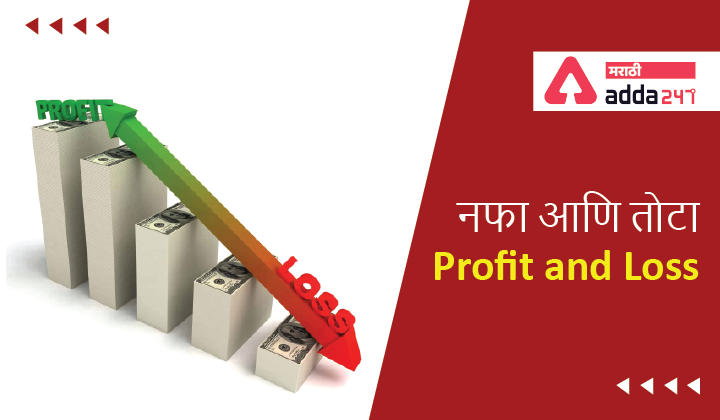Table of Contents
Profit and Loss Formula
Profit and Loss Formula: In this article we have provided very useful Profit and Loss Formula, Profit and Loss is a part of Quantitative aptitude/Mathematics subject of Competitive Exams. So lets learn important concept and Profit and Loss Formula list.
| Profit and Loss Formula | |
| Category | Study Material |
| Exam | MPSC and Other Exams |
| Subject | Quantitative Aptitude |
| Name | Profit and Loss Formula |
Profit and Loss Formula, Sample Questions
Profit and Loss Formula: नफा आणि तोटा (Profit and Loss) हा दैनंदिन जीवनात खूप उपयुक्त आहे, त्याशिवाय नफा आणि तोटा हा विषय MPSC आणि इतर स्पर्धा परीक्षेत खूप आवडीचा विषय आहे. दरवर्षी Profit and Loss वर तलाठी आणि इतर सरळ सेवा स्पर्धा परीक्षेत प्रश्न विचारले जातत. विद्यार्थ्यांनो जर तुम्हाला Quantitative Aptitude किंवा Mathematics मध्ये तुमचे गुण मिळवायचे असतील तर तुम्ही हे शिकलेच पाहिजे.
तपशीलवार, जर तुम्हाला संकल्पना माहित असेल आणि विषय नीट समजला असेल तर तुम्ही सहजपणे Profit and Loss चे प्रश्न सोडवू शकता. त्यामुळे आपण या लेखात Profit and Loss Formula पाहुयात जेणेकरून आपला Profit and Loss टॉपिक चांगला प्रकारे तयार होईल. या लेखात आपण Profit and Loss (नफा आणि तोटा) हा topic दोन्ही भाषेत म्हणजेच English आणि मराठी मध्ये शिकुयात जेणेकरून तुम्हाला तुमच्या सोईनुसार आवडेल त्या भाषेत या topic cover करता येईल.
Profit and Loss : Concepts | नफा आणि तोटा: संकल्पना
Profit/नफा:
When, in a transaction, the selling price is greater than the cost price, it means we earn a profit. If the selling price of an article is greater than its cost price, there is a gain in the transaction. The basic formula used for calculating the profit is:
Profit = Selling Price – Cost Price.
जेव्हा, एखाद्या व्यवहारात, विक्री किंमत खर्चाच्या किमतीपेक्षा जास्त असते, याचा अर्थ आपल्याला नफा मिळतो. एखाद्या वस्तूची विक्री किंमत त्याच्या किमतीपेक्षा जास्त असल्यास, व्यवहारात फायदा होतो. नफा मोजण्यासाठी वापरलेले मूलभूत सूत्र आहे:
नफा = विक्री किंमत – खरेदी किंमत.
Loss/तोटा :
When, in a transaction, the cost price is greater than the selling price, it means we incur a loss. If the selling price of an article is lesser than the cost price, there is a loss in the transaction. The basic formula used for calculating the loss is:
Loss = Cost Price – Selling Price
जेव्हा, एखाद्या व्यवहारात, खर्चाची किंमत विक्रीच्या किंमतीपेक्षा जास्त असते, याचा अर्थ आपल्याला तोटा होतो. एखाद्या वस्तूची विक्री किंमत खरेदी किमतीपेक्षा कमी असल्यास व्यवहारात तोटा होतो. तोटा मोजण्यासाठी वापरलेले मूलभूत सूत्र आहे:
तोटा = खरेदी किंमत – विक्री किंमत
Cost Price/खेरेदी किंमत
The price at which an article is purchased is called its cost price.
वस्तू ज्या किंमतीला खरेदी केली जाते त्याला त्याची खेरेदी किंमत म्हणतात.
Selling Price/विक्री किंमत:
The price at which an article is sold is known as the selling price of the article.
एखादी वस्तू ज्या किंमतीला विकली जाते त्याला त्या वस्तूची विक्री किंमत म्हणून ओळखली जाते.
Marked Price/चिन्हांकित/छापील किंमत:
Marked price is the price set by the seller on the label of the article. It is a price at which the seller offers a discount. After the discount is applied on the Marked price, it is sold at a reduced price known as the selling price.
छापील किंमत ही विक्रेत्याने वास्तूच्या लेबलवर सेट केलेली किंमत आहे. ही एक किंमत आहे ज्यावर विक्रेता सूट देतो. चिन्हांकित/छापील किंमतीवर सूट लागू केल्यानंतर, विक्री किंमत म्हणून ओळखल्या जाणार्या कमी किमतीवर विकली जाते.
Discount/सूट
To cope with the competition in business and boost the sale of goods, shopkeepers offer discounts to customers. The rebate or the offer given by the shopkeepers to lure the customers is called a discount. Discount is always calculated on the Marked price of the article.
व्यवसायातील स्पर्धेला तोंड देण्यासाठी आणि वस्तूंच्या विक्रीला चालना देण्यासाठी दुकानदार ग्राहकांना सूट देतात. ग्राहकांना आकर्षित करण्यासाठी दुकानदारांनी दिलेली सूट किंवा ऑफर याला डिस्काउंट म्हणतात. सूट नेहमी वस्तूच्या चिन्हांकित/छापील किंमतीवर मोजली जाते.
Profit and Loss Examples | नफा आणि तोटा उदाहरणे
- If you buy a bag for Rs 100 and sell it for Rs 130, the profit is Rs 30.
- If you buy a bag for Rs 100 and sell it for Rs 80, the loss is Rs 20.
- If you buy a bag for Rs 100 and sell it for Rs 120, the profit is Rs 20%.
- जर तुम्ही 100 रुपयांना एक पिशवी विकत घेतली आणि ती 130 रुपयांना विकली तर तुम्हाला झालेला नफा 30 रुपये आहे.
- जर तुम्ही 100 रुपयांना एक पिशवी विकत घेतली आणि ती 80 रुपयांना विकली तर तुम्हाला झालेला नुकसान 20 रुपये आहे.
- जर तुम्ही 100 रुपयांना एक पिशवी विकत घेतली आणि ती 120 रुपयांना विकली तर तुम्हाला झालेला नफा 20 आहे.
Profit and Loss Formula | नफा आणि तोटा सूत्र
- Profit = SP – CP
- Loss = CP – SP
- Profit (%) = {Profit/CP} × 100
- Loss (%) = {Loss/CP} × 100
- Discount = Marked Price – Selling Price
- Discount (%) = (Discount/MP) × 100
- SP= [(100+ Gain%)/ 100]x CP
- SP= [(100- Loss%)/ 100]x CP
- CP= [100/ (100+ Gain%)]x SP
- CP= [100/ (100- Loss%)]x SP
- नफा = विक्री किंमत – खरेदी किंमत
- नुकसान = खरेदी किंमत – विक्री किंमत
- नफा (%) = {नफा/खरेदी किंमत} × 100
- तोटा (%) = {तोटा/खरेदी किंमत} × 100
- सूट = चिन्हांकित/छापील किंमत – विक्री किंमत
- सूट (%) = (सूट/छापील किंमत) × 100
- विक्री किंमत= [(100+ नफा%)/ 100]x खरेदी किंमत
- विक्री किंमत= [(100- तोटा%)/ 100]x खरेदी किंमत
- खरेदी किंमत= [100/ (100+ नफा%)]x विक्री किंमत
- खरेदी किंमत= [100/ (100- तोटा%)]x विक्री किंमत

Profit and Loss: Sample Questions | नफा आणि तोटा: नमुना प्रश्न
Q1. An article is bought for Rs. 675 and sold for Rs. 900. Find the gain percent?
Explanation:
- 900 – 675 = 225
- 225/675*100
- = 33 1/3%
Q1. एक वस्तू 675 रुपयांना विकत घेतली जाते आणि 900 रुपयांना विकले जाते. नफा टक्केवारी शोधा?
- 900 – 675 = 225
- 225/675*100
- = 33 1/3%
Q2: An article is purchased for Rs. 450 and sold for Rs. 500. Find the gain percent.
Solution:
Gain = SP – CP = 500 – 450 = 50.
Gain% = (50/450)*100 = 100/9 %
Q2. एक वस्तू 450 रुपयांना विकत घेतली जाते आणि 500 रुपयांना विकले जाते. नफा टक्केवारी शोधा?
स्पष्टीकरण:
नफा = SP – CP = 500 – 450 = 50.
नफा% = (50/450)*100 = 100/9 %
Q3. A person buys a horse for 15 pounds. After one year, he sells it for 20 pounds. After one year, again he buys the same horse at 30 pounds and sells it for 40 pounds. What is the overall profit percent for that person over both the transactions?
Explanation:
- Total C.P. = 45
- Total S.P. = 60
- Profit% = (15/45) *100 = 33.33%
एकूण विक्री किंमत = 60$
नफा% = (15/45) *100 = 33.33%
Q4. In a transaction, the profit percentage is 80% of the cost. If the cost further increases by 20% but the selling price remains the same, how much is the decrease in profit percentage?
Solution:
Let us assume CP = Rs. 100.
Then Profit = Rs. 80 and selling price = Rs. 180.
The cost increases by 20% → New CP = Rs. 120, SP = Rs. 180.
Profit % = 60/120 * 100 = 50%.
Therefore, Profit decreases by 30%.
Q4. व्यवहारात, नफ्याची टक्केवारी खर्चाच्या 80% असते. जर खरेदी किंमत आणखी 20% वाढली परंतु विक्री किंमत तीच राहिली तर नफ्याच्या टक्केवारीत किती घट होईल?
स्पष्टीकरण:
खरेदी किंमत 100 रु असे गृहीत धरुयात.
त्यामुळे नफा = रु. 80 आणि विक्री किंमत = रु. 180.
खर्च 20% ने वाढतो → नवीन खरेदी किंमत = रु. 120, आणि विक्री किंमत = रु. 180.
नफा % = 60/120 * 100 = 50%.
त्यामुळे नफा 30% कमी होतो.
Q5. A man bought some toys at the rate of 10 for Rs. 40 and sold them at 8 for Rs. 35. Find his gain or loss percent.
Solution:
Cost price of 10 toys = Rs. 40 → CP of 1 toy = Rs. 4.
Selling price of 8 toys = Rs. 35 → SP of 1 toy = Rs. 35/8
Therefore, Gain = 35/8 – 4 = 3/8.
Gain percent = (3/8)/4 * 100 = 9.375%
Q5. एका माणसाने 10 खेळणी 40 रुपयांना याप्रमाणे खरेदी केले आणि त्यांनी 8 खेळणी 35 रुपयांना याप्रमाणे विकले असता. त्यांना झालेला नफा किंवा तोटा टक्केवारी शोधा.
स्पष्टीकरण:
10 खेळण्यांची खरेदी किंमत = रु. 40 → 1 खेळण्याची खरेदी किंमत = रु. 4.
8 खेळण्यांची विक्री किंमत = रु. 35 → 1 खेळण्याची विक्री किंमत = रु. 35/8
म्हणून, नफा = 35/8 – 4 = 3/8.
नफा %= (3/8)/4 * 100 = 9.375%
Q6. A shopkeeper offers a discount of 20% on the selling price. On a special sale day, he offers an extra 25% off coupon after the first discount. If the article was sold for Rs. 3600, find
- The marked price of the article and
- The cost price if the shopkeeper still makes a profit of 80% on the whole after all discounts are applied.
Solution:
Let the marked price of the article be x.
First a 20% discount was offered, on which another 25% discount was offered.
So, 75% of 80% of x = 3600
75/100 * 80/100 * x = 3600 → x = 6000.
So the article was marked at Rs. 6000.
Cost price of the article = [100/(100+80)]*3600 = Rs. 2000.
It is important to note here that this DOES NOT equal to a 45% discount on the whole. When different discounts are applied successively, they CANNOT be added.
Q6. दुकानदार विक्रीच्या किमतीवर 20% सूट देतो. विशेष विक्रीच्या दिवशी, तो पहिल्या सवलतीनंतर 25% अतिरिक्त कूपन ऑफर करतो. जर वस्तूची विक्री किंमत रु. 3600 असेल तर खालील ला विकला गेला. तर खालील गोष्टी शोधा.
- लेखाची चिन्हांकित/छापील किंमत आणि
- सर्व सूट लागू केल्यानंतरही दुकानदाराने एकूण 80% नफा कमावल्यास खरेदी किंमत शोधा.
स्पष्टीकरण:
वस्तूची छापील/चिन्हांकित किंमत x असे समजूयात.
प्रथम 20% सूट ऑफर केली गेली, ज्यावर आणखी 25% सूट देण्यात आली.
तर, x = 3600 च्या 80% च्या 75%
75/100 * 80/100 * x = 3600 → x = 6000.
त्यामुळे वस्तूची छापील/चिन्हांकित किंमत रु. 6000.
वस्तूची खरेदी किंमत = [100/(100+80)]*3600 = रु. 2000.
येथे हे लक्षात घेणे महत्त्वाचे आहे की हे एकूण 45% सूटच्या बरोबरीचे नाही. जेव्हा वेगवेगळ्या सूट लागोपाठ लागू केल्या जातात, तेव्हा त्या जोडल्या जाऊ शकत नाहीत.

महाराष्ट्रातील सर्व स्पर्धा परीक्षांसाठी ऑनलाईन क्लास, व्हिडिओ कोर्स, टेस्ट सिरीज, पुस्तके आणि इतर अभ्यास साहित्य खाली दिलेल्या लिंक वर क्लिक करून मिळावा.
| Latest Maharashtra Govt. Jobs | Majhi Naukri 2023 |
| Home Page | Adda 247 Marathi |
| Current Affairs in Marathi | Chalu Ghadamodi |
YouTube channel- Adda247 Marathi
Adda247 मराठी App | Add247Marathi Telegram group









